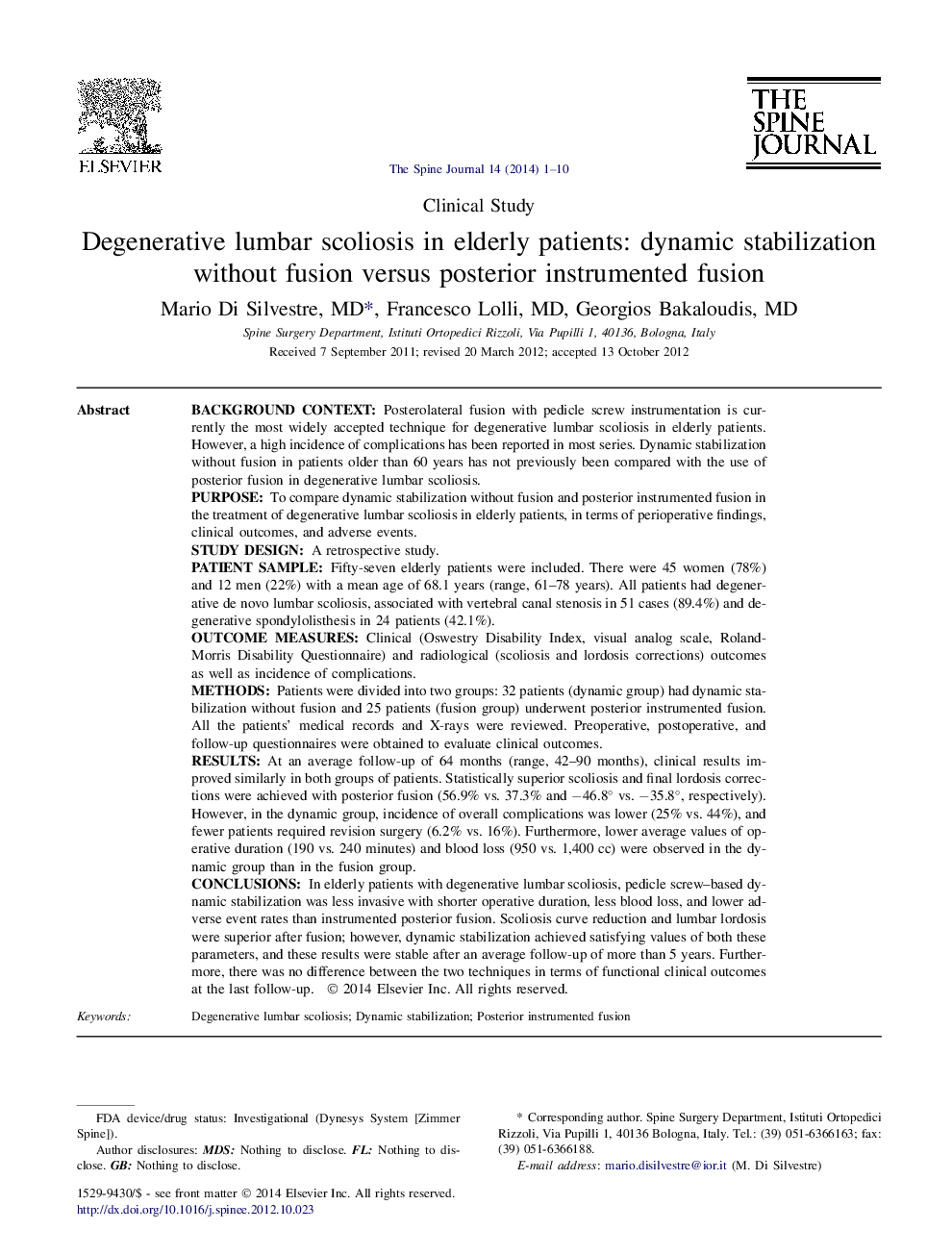| کد مقاله | کد نشریه | سال انتشار | مقاله انگلیسی | نسخه تمام متن |
|---|---|---|---|---|
| 6212593 | 1268584 | 2014 | 10 صفحه PDF | دانلود رایگان |
Background contextPosterolateral fusion with pedicle screw instrumentation is currently the most widely accepted technique for degenerative lumbar scoliosis in elderly patients. However, a high incidence of complications has been reported in most series. Dynamic stabilization without fusion in patients older than 60 years has not previously been compared with the use of posterior fusion in degenerative lumbar scoliosis.PurposeTo compare dynamic stabilization without fusion and posterior instrumented fusion in the treatment of degenerative lumbar scoliosis in elderly patients, in terms of perioperative findings, clinical outcomes, and adverse events.Study designA retrospective study.Patient sampleFifty-seven elderly patients were included. There were 45 women (78%) and 12 men (22%) with a mean age of 68.1 years (range, 61-78 years). All patients had degenerative de novo lumbar scoliosis, associated with vertebral canal stenosis in 51 cases (89.4%) and degenerative spondylolisthesis in 24 patients (42.1%).Outcome measuresClinical (Oswestry Disability Index, visual analog scale, Roland-Morris Disability Questionnaire) and radiological (scoliosis and lordosis corrections) outcomes as well as incidence of complications.MethodsPatients were divided into two groups: 32 patients (dynamic group) had dynamic stabilization without fusion and 25 patients (fusion group) underwent posterior instrumented fusion. All the patients' medical records and X-rays were reviewed. Preoperative, postoperative, and follow-up questionnaires were obtained to evaluate clinical outcomes.ResultsAt an average follow-up of 64 months (range, 42-90 months), clinical results improved similarly in both groups of patients. Statistically superior scoliosis and final lordosis corrections were achieved with posterior fusion (56.9% vs. 37.3% and â46.8° vs. â35.8°, respectively). However, in the dynamic group, incidence of overall complications was lower (25% vs. 44%), and fewer patients required revision surgery (6.2% vs. 16%). Furthermore, lower average values of operative duration (190 vs. 240 minutes) and blood loss (950 vs. 1,400 cc) were observed in the dynamic group than in the fusion group.ConclusionsIn elderly patients with degenerative lumbar scoliosis, pedicle screw-based dynamic stabilization was less invasive with shorter operative duration, less blood loss, and lower adverse event rates than instrumented posterior fusion. Scoliosis curve reduction and lumbar lordosis were superior after fusion; however, dynamic stabilization achieved satisfying values of both these parameters, and these results were stable after an average follow-up of more than 5 years. Furthermore, there was no difference between the two techniques in terms of functional clinical outcomes at the last follow-up.
Journal: The Spine Journal - Volume 14, Issue 1, 1 January 2014, Pages 1-10
